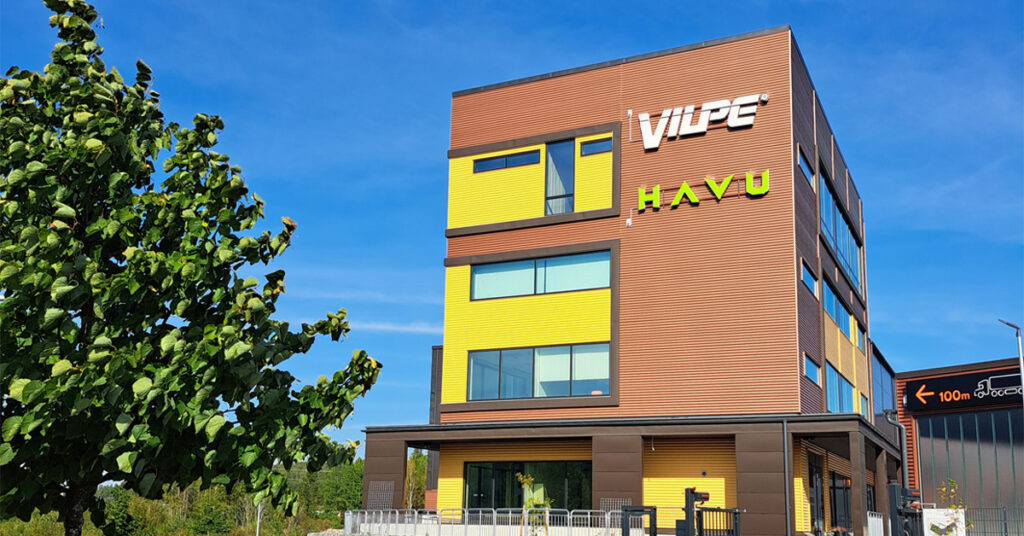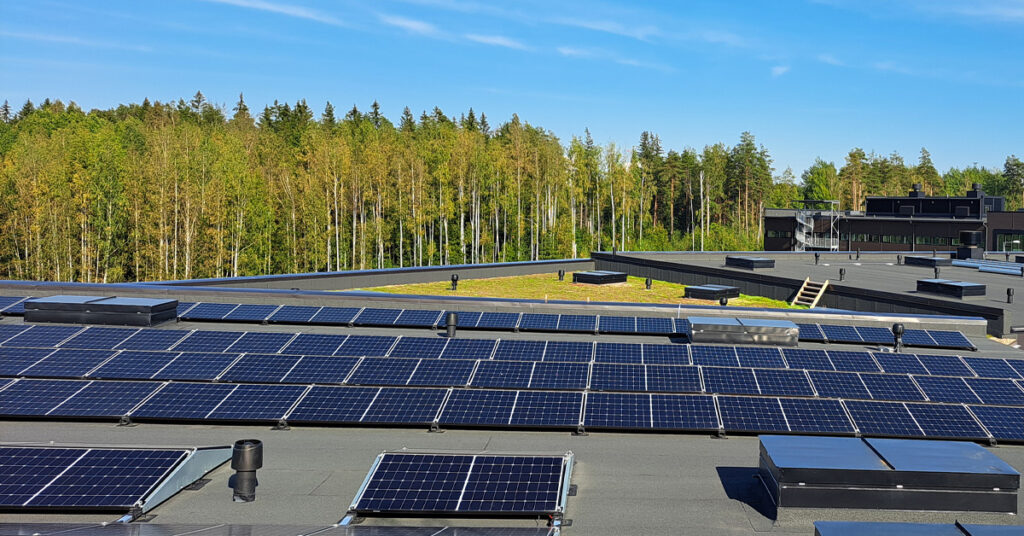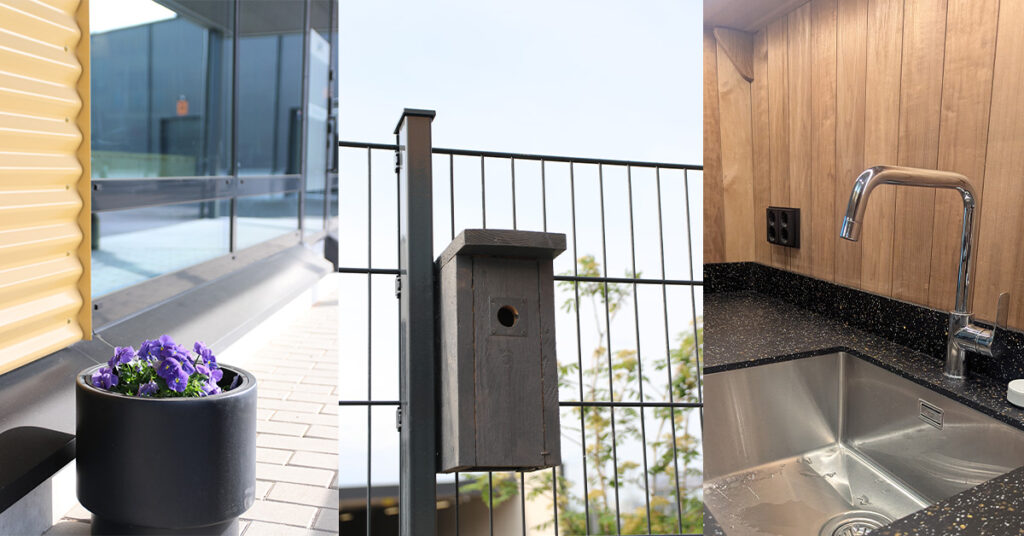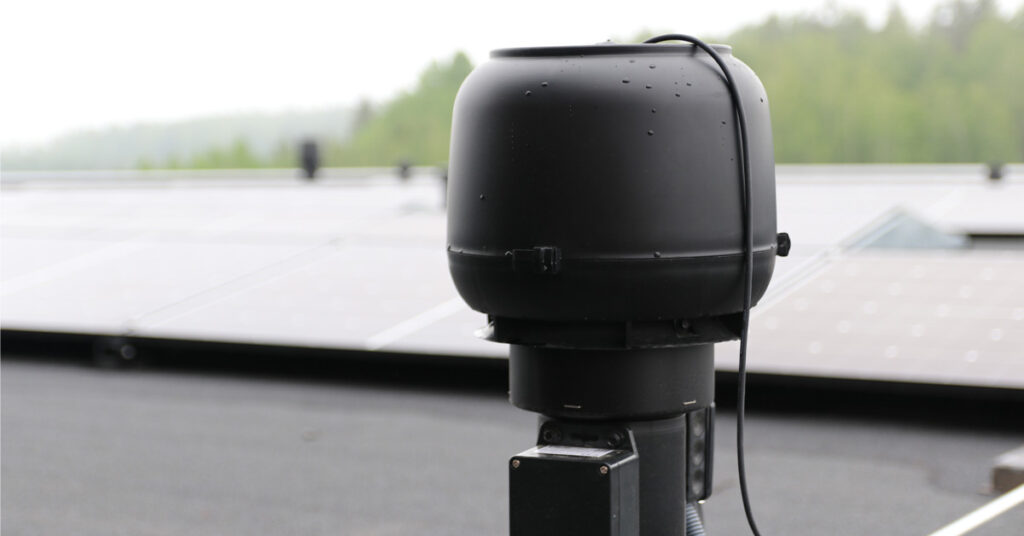VILPE’s Vantaa office achieved Finland’s highest-ever BREEAM In-Use score: Here’s how it succeeded

VILPE’s Vantaa office achieved in 2025 Finland’s highest-ever measured BREEAM In-Use (BIU) score. The Outstanding level requires at least 85 percent, which is possible only by collecting points evenly across multiple areas. In this article, we explain what solutions led to the top result.
Environmental responsibility has long been one of VILPE’s core values. When the company decided to build a new office in Vantaa, it was clear from the start that it would be done in an environmentally conscious manner. For years, VILPE had made investments at its headquarters and factory in Korsholm, Finland. Among these were one of Ostrobothnia’s largest solar power plants, smart LED lighting, and recycling of surplus material.
“In the era of greenwashing, BREEAM certification was important to us because we wanted to verify our green actions. Initially, we aimed for the Excellent level, but when it became clear that with reasonable additional measures the points would rise to the Outstanding level, we naturally carried out the necessary additional actions,” says VILPE’s CEO Tuomas Saikkonen.
The project was managed by VILPE’s Technical Director Timo Anttila. According to him, reaching the high level was relatively easy in terms of energy monitoring and control thanks to a modern building automation system, to which different systems can be flexibly connected.
“When you have a modern automation platform with open interfaces, it is easy to add new measurements and controls. It must be easy both for the user and for the administrator – otherwise its benefit will remain incomplete,” Anttila explains.
How the points were earned

BREEAM In-Use assesses the environmental performance and maintenance of an existing building, whereas BREEAM New Construction focuses on design and implementation during the construction phase. In BREEAM In-Use assessments, points are awarded in eight categories, the most central being energy efficiency and energy consumption management, indoor conditions and user well-being, water use and monitoring, and management of materials and resources. In addition, accessibility and transport are examined, such as proximity to public transport and cycling-supporting arrangements. Land use and biodiversity-supporting solutions, as well as systems related to the building’s safety and emissions management, are also considered.
VILPE’s Vantaa office was assessed by Sustera’s assessor Heidi Ahoste. She emphasizes that VILPE’s achievement is based on consistently strong performance across all categories.
“The 85 percent threshold for Outstanding can in practice only be exceeded if the building is good across the board. A single strength is not enough; points are needed in many areas, widely,” she states.
According to Ahoste, only a few minimum requirements are mandatory, such as water metering and waste management facilities. Most of the points come from optional solutions, and it is advisable to focus on actions that support the building’s intended use and the everyday life of its users. VILPE focused on energy management, lighting, and user-friendly indoor conditions. On the other hand, oil separation wells were consciously not implemented, as the site is not in a groundwater area and traffic load is small. Both Ahoste and Anttila emphasize that not all BREEAM In-Use categories can be influenced. For example, points are awarded for proximity to daycares, shops, and other services, but these may be nearly impossible to affect.
Table 1 presents VILPE’s solutions that raised the BREEAM In-Use certification of the Vantaa office to the Outstanding level. The table summarizes the categories, VILPE’s actions, the raw points, and the weighted results.
Table 1: VILPE’s solutions for achieving BREEAM In-Use Outstanding level
| BREEAM In-Use category | VILPE’s choices and implementation | Raw points | Weighted result (%) | Comments / impact |
| Energy (ENE) | Extensive building automation, alarm thresholds, CO₂ control, LED lighting | 23,36 / 25 | 27,0 % | VILPE’s strongest category. The system enables real-time consumption monitoring and automatic adjustment. |
| Health and Well-being (HEA) | Finetuning of design lamps, automatic blinds, user control | 16,00 / 20 | 19,4 % | The broad HEA set was fulfilled; required adjustments especially in design lamps. |
| Transport (TRA) | Frame-lockable bicycle parking, changing rooms | 3,41 / 5 | 3,7 % | Supports sustainable transport. |
| Water (WAT) | Leak alarms, alarm thresholds, real-time monitoring | 10,08 / 11 | 10,1 % | Nearly full points; automation speeds up leak detection. |
| Resources (RSC) | Recycling, comprehensive inventory | 15,01 / 13 | 9,8 % | Careful material management raised points above the basic maximum. |
| Land Use and Ecology (LUE) | Green roof, plantings, birdhouses | 2,00 / 4 | 1,0 % | Points were gained through the green roof, plantings, and birdhouses. |
| Resilience (RSL) | Fire and burglary alarms connected to 24/7 monitoring | 12,26 / 13 | 8,6 % | Nearly full points; connecting alarms to 24/7 monitoring strengthened both safety and responsibility in property management. |
| Pollution (POL) | Refrigerant leak monitoring, no oil separation wells | 4,50 / 9 | 2,9 % | Points from air quality and refrigerant leaks; no oil separation wells, as they were not needed. |
| Additional points | Particularly good actions (e.g., water measurement, demand response) | +4,0 | 4,0 % | The BREEAM In-Use system allows a maximum of 10 additional points – VILPE scored 4. |
| Note. The points shown in the table are raw points per category. The final certification score is calculated using weightings, which raised VILPE’s office’s overall score to 86.5% (Outstanding). This is the highest BREEAM In-Use score achieved in Finland to date. It should also be noted that the BREEAM In-Use criteria become stricter annually, and therefore scores from different buildings are not necessarily directly comparable. | ||||
As the table shows, VILPE received the highest scores in energy management (ENE, 23.36 pts) and health and well-being (HEA, 16.0 pts). Together, these accounted for nearly half of the total score. In resource management (RSC) the points even rose above the category’s maximum limit, and water (WAT) brought nearly full points thanks to leak alarms and automatic monitoring. Resilience (RSL) was strengthened by connecting fire and burglary alarms to a 24/7 monitoring centre. By contrast, land use and ecology (LUE) and pollution (POL) remained lower, but the this was appropriate for the Vantaa site’s location and intended use.
Ahoste emphasizes that for BREEAM In-Use certification, energy and water management are nevertheless the most critical, because their weighting in the assessment is high. In energy monitoring, calculated energy efficiency alone is not enough; consumption must be measurable and controllable during operation. In Vantaa, this was implemented with a comprehensive, remotely monitored metering system that enables real-time monitoring for both technical personnel and building users. Separate alarm thresholds were defined so that, for example, potential water leaks are detected quickly.
Points in Energy (ENE) were earned from solar panels, extensive sub-metering, and energy-efficient lighting. All end uses with significant energy consumption are sub-metered, exterior lighting is equipped with automatic energy-saving functions, and the elevators meet energy-efficiency requirements. In the Water section (WAT), points were earned because all toilets, faucets, and showers are water-saving, home appliances consume little water. An automatic leak detector as well as shut-off valves were added to the water network.

According to Anttila, the energy management section went smoothly and cost-effectively, since the same energy management system used at VILPE’s Korsholm factory could be utilized at the Vantaa office.
“A positive surprise during the project was that we got very far with the solutions we had already applied back at the Korsholm factory. The system saves us tens of thousands of euros annually there. It was easy to copy the working concept to Vantaa where applicable,” Anttila says.
At the Vantaa office, the system has also been expanded to room-specific monitoring: in addition to water and electricity, ventilation and lighting are monitored. In meeting rooms, carbon dioxide concentration is also monitored, and the system adjusts ventilation automatically to ensure optimal air quality. The ventilation of the sauna and shower rooms is controlled based on temperature and humidity.
The building’s lighting is part of the health and well-being category (HEA). According to BREEAM In-Use criteria, in at least 80 percent of workspaces the lighting must meet precise illuminance requirements (around 500 lx at workstations), and glare must be limited (UGR value within standards). At the Vantaa office, lighting was implemented automatically, but users have the possibility to adjust the lights themselves. This supports both user experience and scoring. According to Anttila, finetuning was especially required with design lamps.

“With design lamps, appearance is often considered more important than efficiency, and therefore the lighting plan had to be adjusted so that all spaces met the requirements,” Anttila says.
In resources (RSC), comprehensive waste management brought points: separate facilities for sorting waste and for reusable materials, an expanded resource inventory, and the adaptability of the spaces. Resilience (RSL) was strengthened, in addition to a flood risk assessment and analysis of natural hazards, by structural protections and by connecting fire and burglary alarms to a 24/7 monitoring centre. In pollution (POL), points were earned from the fact that the building is heated with electricity without combustion-based systems, as well as from automatic detection of refrigerant leaks.
Moderate additional investments made the difference
Initially, the Vantaa office achieved about 72–74.8 raw points, which would have been enough for the BREEAM In-Use Excellent level. By adding a few practical solutions, the score ultimately rose to 86.5 percent, and thus the office reached the Outstanding level.
These additional solutions included, among other things, a stricter-than-usual waste management plan. In addition, frame-lockable bicycle parking were implemented, showers were adjusted to minimize water consumption, leak alarms were added to the main water meter and the refrigerant system, ventilation units were programmed with time controls, and outdoor lighting was connected to automatic control. A comprehensive resource inventory was also prepared, which brought points for responsible use and management of materials.

The rise from Excellent to Outstanding required additional investments, the costs of which were about 200,000 euros. This was a reasonable increase in relation to the overall project costs and the value of the building. Better windows increased costs by about 15,000 euros, sun glare control (HEA02) about 30,000 euros, and HEA09 measures 5,000 euros. Broader accessibility solutions cost about 2,000 euros, and a stricter waste sorting solution 30,000 euros. In addition, solar panels (60,000 euros) and a green roof (30,000 euros) were installed on the building’s roof. Smaller improvements included, among other things, improvements to showers, plantings, water taps, and route signage (30,000 euros). Security and fire alarms also resulted in a one-time cost of about 30,000 euros and a monthly cost of 300 euros. According to Anttila, many solutions – such as the green roof, leak detectors, and energy-efficient taps – would probably not have been implemented without the BREEAM In-Use certification.
Advanced systems require learning from building users
Although modern systems improve energy efficiency and environmental friendliness, they are not always user-friendly. According to Anttila, adopting new systems is the most difficult part of the project.
“Such a building requires awareness and discipline from the user to learn something new. If you are used to a traditional office building, this demands a completely different attitude. When there are many options and adjustment possibilities, user training is also needed so that the systems can be fully utilized. This is a challenge for all manufacturers: how to make solutions not only environmentally friendly but also genuinely easy to use,” says Anttila.
VILPE Sense monitors the entire roof of the building

At the Vantaa office, the company’s own VILPE Sense system is also extensively utilized, monitoring the building’s roof and envelope for humidity damage. VILPE’s Product Manager Kimmo Kujala explains that the building uses both a humidity control and a leak detection system: a total of 109 leak detectors and 14 roof fans have been installed on the roof, one of which ventilates the crawl space. The VILPE Sense humidity control system ventilates roof structures as needed, and VILPE Sense leak detectors help locate leaks. According to Kujala, sensors have also been placed elsewhere in the building’s envelope as part of VILPE Sense product development.
The roof insulation material was chosen as a combination of EPS insulation and rigid wool due to the loads of the solar panels. Since solar panels are heavy, it is difficult to monitor the condition of the roof underneath them without smart sensors. In addition, fastening solutions are not harmonized in Europe, and therefore solar panels multiply the risk of damage. The same applies to the green roof area: when vegetation covers the roof surface, possible humidity damage can easily remain hidden.
VILPE Sense measures humidity in the insulation layer and warns of leaks quickly, thus avoiding extensive and environmentally burdensome repairs. The VILPE Sense system was not part of the BREEAM In-Use assessment, but it generally supports the building’s environmental friendliness and long lifecycle by reducing the environmental burden of humidity damage and its repairs.
The Vantaa project developed VILPE’s expertise

According to CEO Tuomas Saikkonen, achieving the BREEAM In-Use Outstanding level not only increased the value of the Vantaa office but also strengthened the expertise of the entire organization.
“The project ensured and validated that we act in accordance with our values. At the same time, it taught us a lot of new things about environmentally friendly construction. We work with building technology every day, and this project developed both our organization and our own technical experience and know-how,” Saikkonen summarizes.
What is BREEAM?
- BREEAM (Building Research Establishment Environmental Assessment Method) is the world’s oldest and one of the most respected environmental certification systems for buildings.
- Certification assesses, among other things, energy efficiency, water use, indoor conditions, material choices, waste management, and the lifecycle impacts of the building.
- There are six levels: Acceptable, Pass, Good, Very Good, Excellent, and Outstanding.
- Outstanding is the highest possible level, achieved by only few buildings internationally.
- In Finland, the certificate is becoming more common, but Outstanding-level buildings are still rare.
VILPE’s tips for implementing a BREEAM In-Use Outstanding-level office
1 Make monitoring easy and genuinely useful.
Collecting data alone is not enough: what matters is that it is easily accessible and that results can be easily analyzed and they support decision-making. Only the analyzed information leads to energy savings and helps develop the long-term operation of the property. A modern building automation system is key.
2 Choose experienced partners.
Understanding the requirements of BREEAM In-Use certification is difficult for a beginner. With inexperienced designers or contractors, much of the time can be spent guiding them through the criteria, while the risk of mistakes increases. The project runs much more smoothly when partners have experience with similar projects. A certification consultant is also an important aid in the planning phase.
3 Prepare to train users.
Technically advanced systems are not always self-explanatory to use. To gain full benefit from the solutions, user training and clear instructions are needed. Users must understand the logic and adjustment options of the systems so that they support both energy efficiency and everyday convenience.
4 Select the criteria correctly.
Not everything can be influenced, and resources should be directed at those areas that support the building’s intended use. In VILPE’s case, oil separation wells were not implemented, as they were not considered necessary for the building’s function.
5 Prepare for additional costs – and savings.
The Outstanding level requires more planning and detail, but long-term savings can be achieved in operating and maintenance costs. In addition, if financing is sought for the project, committing to Excellent or Outstanding level can reduce the margin required by the bank or financial institution.
6 Ensure management commitment.
Increases in construction-phase costs, and especially unexpected additional costs during the project to reach the target level, can bring the certification process to a halt. This may happen if company management is not aware of this possibility and not motivated to stick with the goals despite it. Ensure management commitment with a thorough briefing and open communication during the project.
